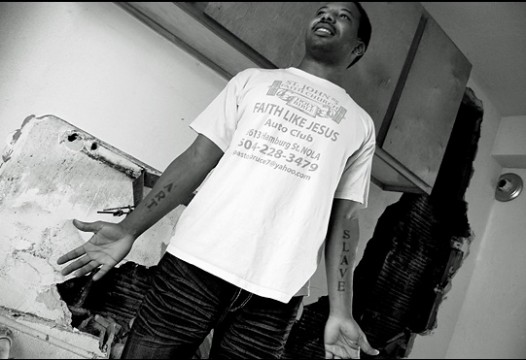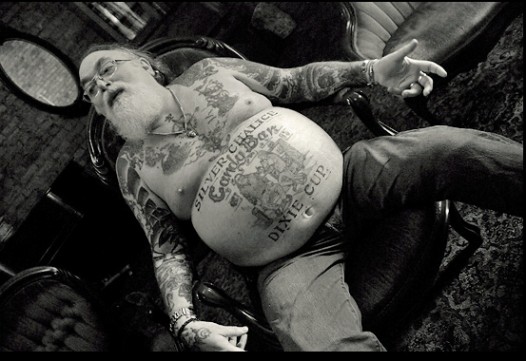Throughout the history of photography, art historians and critics have questioned the capability of photographs to capture the “reality” of a moment or of their subjects. Most photographs tell a narrative, one that is often a combination of the subject of the photograph and the photographer’s perception of that subject – as well as the viewer’s interpretation. Yet the 60 photographs from Miriam Waterman’s Babel series challenge the degree to which “reality” can be conveyed in a photograph.

Self-proclaimed ‘classy bum’ George A. Jena shows his strength in Waterman’s ‘Survivor.’ (photo courtesy of the artist)
In the 25 photographs that will be on display at Waterman’s Babel exhibition, opening Saturday, December 10, at Coup d’oeil art consortium, it is evident that Waterman’s process is a collaborative one. Waterman selects the subjects for her photographs, mostly artists from New Orleans, but in an effort to focus on their self-perceptions rather than perceptions that she or other outsiders might inflict upon them, she engages her subjects in her creative process.
Sitters are asked to choose a word “that they feel epitomizes a core aspect of their identity,” where they want the word printed on their bodies, and the location in which their photograph will be taken. Waterman is willing to cede these elements of creative control for the greater intention of her series: to document members of the New Orleans art community as “they want to be captured” without “influenc[ing] or impos[ing] [her] viewpoint.”

In ‘Art Slave’ Bruce Davenport, Jr. expresses his devotion to his art. (photo courtesy of the artist)
To Waterman, this series is an effort to identify the artists who comprise the art community of New Orleans. Schools of artists from New York (the New York School) to Los Angeles (the Cool School) have been identified and memorialized by photographs that capture them, if not at the zenith of their careers, then at least partaking in the daily activities of the then-contemporary art society. Inspired by these enduring images of ephemeral moments, Wateman seeks to record the current art scene.
Even as a non-native New Orleanian, Waterman can appreciate the vibrancy and unique undercurrent of New Orleans’ art scene. Her photographs are evidence of this as she allows her sitters to project whatever image of themselves they want to express to the public, rather than focusing on their celebrity or public persona. They seem to convey the “go with the flow” mentality that is innate to New Orleanians and one that most non-natives adapt to in efforts to become part of the strong culture and community of the city.

Billy Seibert’s ‘Silver Chalice Dixie Cup’ blends in with his other body art. (photo courtesy of the artist)
Waterman wants her works to be able to speak for themselves and for the artists they represent. She wants her viewers to have a unique encounter with her subjects. In an ideal world, her viewers would be able to look at the images and feel moved by the imagery, coming to their own conclusions before viewing her artist’s statement.
Waterman acknowledges the significance of artists’ statements and wants her viewers to re-view her exhibition after reading her statement, reconciling their opinions with her intentions. Waterman’s photographs invite exploration both of her art and process and of the self-perceptions of her subjects, an exploration open to the public at her Coup d’oeil exhibition from December 8 – January 7, 2012.
Brianna Smyk has an M.A in Art History from San Diego State University. She lives and works in New Orleans and writes about arts and culture for NolaVie. Read more of Brianna’s articles atwww.beingbreezie.tumblr.com.
 NOLAbeings Multimedia artist Claire Bangser created NOLAbeings as a portrait-based story project that marries...
NOLAbeings Multimedia artist Claire Bangser created NOLAbeings as a portrait-based story project that marries...  Voodoo in New Orleans: Reviving history: New Orleans fortune telling This article takes a deep dive into the history of Voodoo in New Orleans, its hybridization with Catholicism, and its present-day place in the city's culture. The author visits fortune-tellers in the French Quarter, using their guidance as a tool for introspection rather than a deterministic predictor of the future. Through her experiences in New Orleans, the author feels a mystical connection to both the past and the future.
Voodoo in New Orleans: Reviving history: New Orleans fortune telling This article takes a deep dive into the history of Voodoo in New Orleans, its hybridization with Catholicism, and its present-day place in the city's culture. The author visits fortune-tellers in the French Quarter, using their guidance as a tool for introspection rather than a deterministic predictor of the future. Through her experiences in New Orleans, the author feels a mystical connection to both the past and the future. 